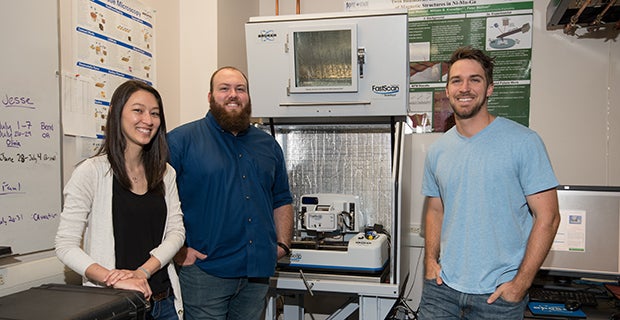
A paper authored by a team of Boise State undergraduate students working in the Micron School of Materials Science & Engineering has been chosen as the cover article for the most recent issue of the Journal of Applied Physics. The paper, “Localized deformation in Ni-Mn-Ga single crystals” describes work carried out by Corey Efaw, Lance Patten, and Courtney Hollar under the guidance of Boise State professors Peter Müllner and Bill Knowlton. Efaw, Patten, and Hollar now are doctoral students at Boise State.
One’s research being highlighted on the cover of a major scientific journal and as well as being the featured article is quite rare and underscores the impact of the research being presented,” Knowlton said. “To put this somewhat in perspective, I have had more requests for copies of the article in the first month of publication than I have had for any article I’ve co-authored. The fact that undergraduate students were co-authors of cover article, performed much of the research, and the image itself was acquired by undergraduate students, is exceptionally rare. As one of the editors told us, ‘it is a big deal.’”
The students studied the nanoscale mechanical and magnetic properties of Ni-Mn-Ga, a magnetic shape memory alloy. These alloys are remarkable because their size and shape can be reversibly transformed with magnetic fields, and their magnetic north pole direction can be similarly reoriented by applying pressure.
By gently pushing on individual crystals of Ni-Mn-Ga with an extremely fine diamond tip, the researchers observed that the mechanical properties of Ni-Mn-Ga depend upon the relative orientation of the crystal’s easy magnetization axis (i.e., the direction in which the magnetic north pole points). They also discovered that following a heating/cooling cycle, the magnetic north pole could flip by 90 degrees, going from pointing out of the surface to lying in the plane of the surface. These new insights into Ni-Mn-Ga’s magnetomechanical properties and the underlying mechanisms behind their observed changes could aid the development of devices that harness its intriguing properties.
“We invented and patented a micropump based on the ‘magnetic shape memory effect’ (i.e. the magnetic-field-controlled shape change of a material),” says Müllner. “The pump utilizes local actuation, i.e. the metal works in a similar way as muscles. The results of this study deepen our basic understanding of magnetic shape memory and its potential for miniaturizing devices. The current micropump helps scientists perform biomedical experiments. We aim at incorporating the micropump to the lab-on-a-chip and later to implant it in the human body as artificial pancreas for diabetics.”
Müllner is an internationally recognized expert in magnetic shape memory alloys, which hold promise for applications as diverse as information storage, microfluidic pumps, actuators and sensors, while Knowlton is an expert in atomic and magnetic force microscopy (AFM and MFM) for characterizing such materials. Other team members included Chad Watson, who has previously co-authored multiple peer-reviewed publications on Ni-Mn-Ga, and lead author Paul Davis. Watson and Davis are the former and current managers, respectively, of the Boise State Surface Science Lab, where much of the experimental work was performed.
In addition to pursuing a deeper fundamental understanding of Ni-Mn-Ga shape memory alloys, Müllner and Knowlton jointly hold a patent with Watson for the use of Ni-Mn-Ga and related MSMAs in multi-state memory devices, while Müllner has founded a start-up company, Shaw Mountain Technology LLC, to commercialize applications of the alloy.